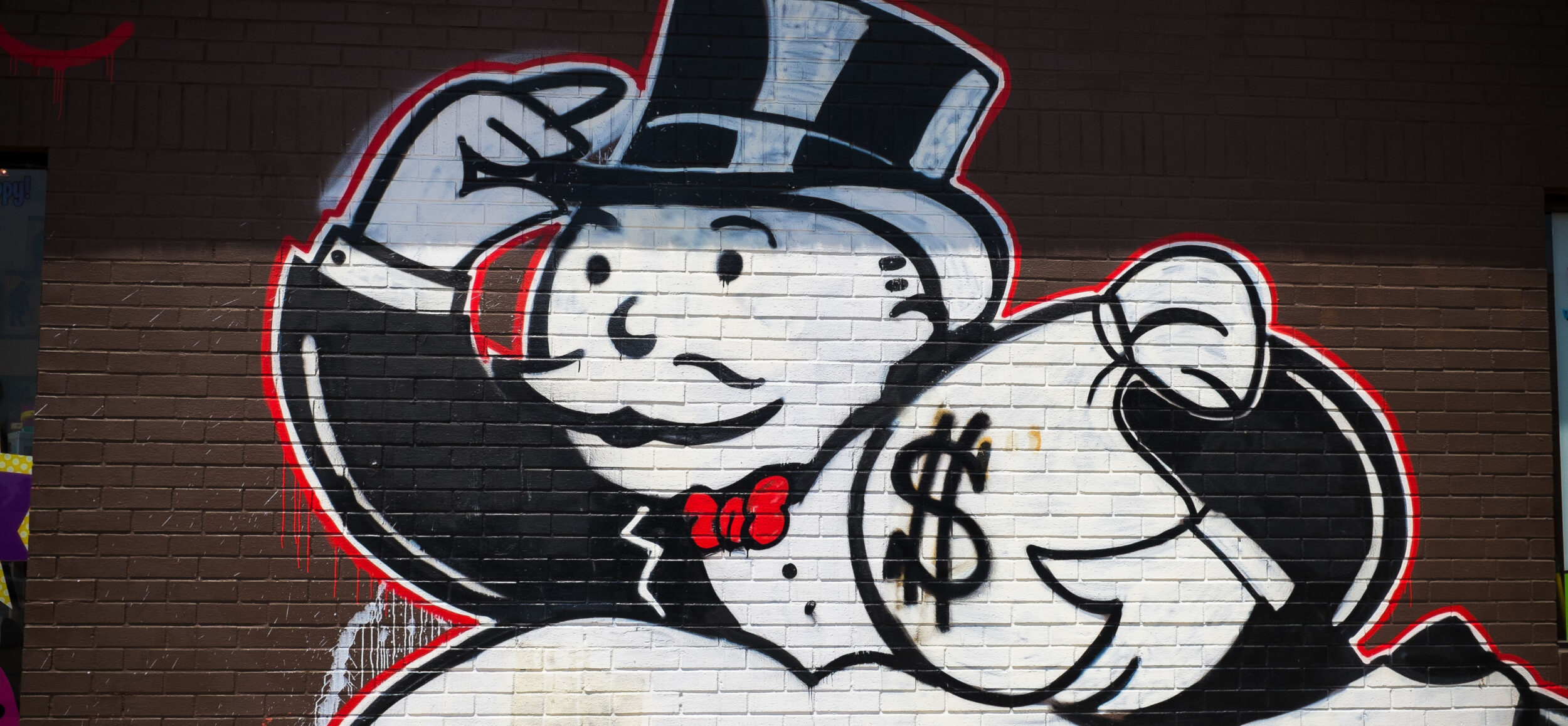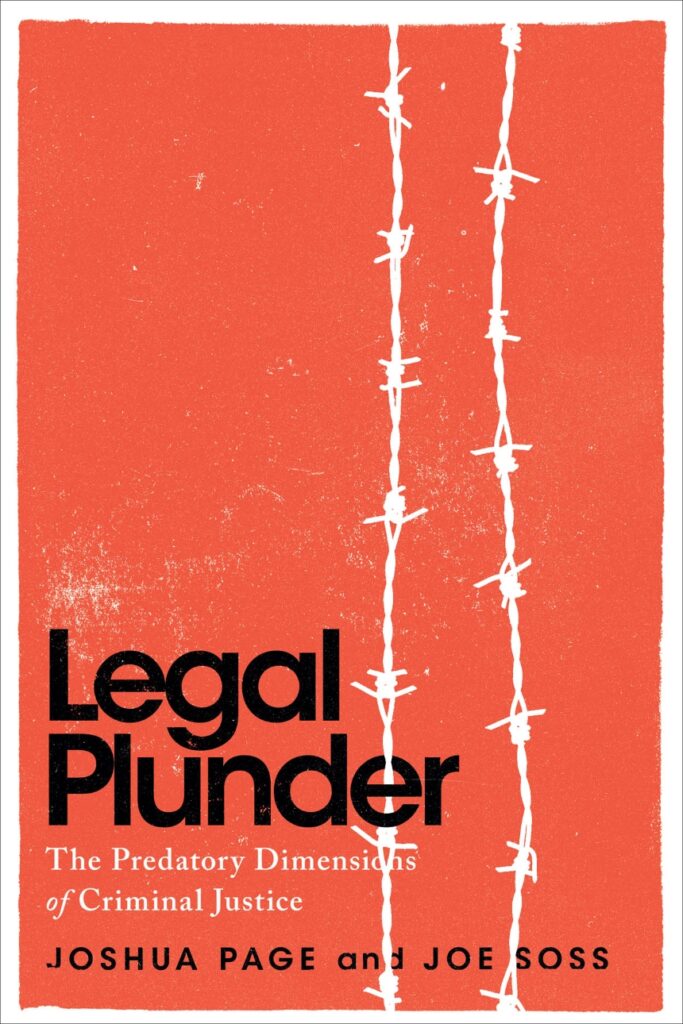Patrick Irving was in a bind. Imprisoned in Idaho, he desperately needed a pair of sneakers. “The plastic bag I sandwich between my two best pairs of socks . . . protects well against the rain that soaks in through [the hole in] my shoe,” he wrote in the New York Times, “but Idaho snow is a formidable foe.” Irving could have bought a new pair from the commissary—a prison store that sells overpriced, low-quality goods—but that would have left him without money for other necessities like food to “stave off hunger pains,” a bar of soap to wash his “parts and pieces,” and “real detergent” to clean his “sweaty clothes in a toilet.” Like most people in prison, Irving was broke. If he got a prison job, he would make only $0.40 an hour. The shoes cost $48.72.
Out in the community, Irving could shop around for better deals. Not so in prison. He and his peers “have only one store to choose from: the commissary. It’s run by a private company called the Keefe Group . . . a subsidiary of TKC, a holding company indirectly controlled by H.I.G. Capital, a private equity firm.” To continue as the sole provider of goods to a captive market, Irving explains, “Keefe rewards the Idaho Department of Corrections with a revenue-sharing arrangement that guarantees a yearly minimum of $1.25 million plus 40 percent of the gross beyond an annual base sales target.” The company and the state agency “benefit from working closely together . . . usually at the expense of their shared clients.”
For most people doing time, Irving’s story is unremarkable. They know all too well that U.S. prisons are shot through with all kinds of revenue-generating schemes. From the get-go, many states charge people pay-to-stay fees for their own imprisonment. Ordinary activities, from sending an email to making a phone call, produce further bills. Family members and friends of the imprisoned tend to be familiar with such practices, too. Severely limited in funds of their own, incarcerated people usually turn to people on the outside for help. Irving, for example, depends on “two sets of recently retired parents” who “pool from their savings approximately $200 a month to help defray” the costs of living in prison. In the United States today, families of incarcerated people spend approximately $2.9 billion each year on phone call and commissary costs alone.
Americans who have never had such experiences, including many well-off readers of the New York Times, might be surprised by such facts, especially given that Irving was writing about a public prison. In liberal political rhetoric and popular media stories, revenue-enhancing practices are usually cast as distinctive features of private, for-profit prisons, in contrast to public facilities. High-profile essays such as Irving’s create a breach in this conventional storyline, exposing the broad sweep of financial exploitation occurring across private and public criminal legal institutions.
More from our decarceral brainstorm
Inquest, finalist for the 2025 National Magazine Award for General Excellence, brings you insights from the people working to create a world without mass incarceration.
Sign up for our newsletter to get the latest in your inbox every Saturday.
Newsletter
Since the mid-1980s, government and business interests have retrofitted criminal legal institutions so that they function as generators of revenue. Today, their routine operations extract billions of dollars annually from the nation’s most oppressed and exploited communities. Our book Legal Plunder: The Predatory Dimensions of Criminal Justice presents a sustained analysis and critique of this development, including its origins, justifications, operations, effects, and contestations.
Intensive methods of financial extraction have become integral features of criminal legal governance in the United States and powerful forces shaping the institutions that implement them. This process has produced a distinctive new chapter in the history of what we call criminal justice predation. It has reconfigured the longstanding relationship between governmental operations that criminalize, police, and punish and extractive projects that use takings from subjugated groups to subsidize and enrich dominant actors and institutions.
The term “predatory,” as we use it, does not designate a type of actor, policy tool, or goal-oriented intention. It refers to social relations that take a particular form—and thus, can be identified by the terms on which they are organized—and to the practices that constitute and enact them. Predatory relations and practices are structured by the dominant and subordinate positions that actors occupy relative to one another and by the terms that organize and regulate their transactions. Specifically, they, first, are based on a subordinated group’s subjugation and exclusion and, second, leverage the subordinated group’s vulnerabilities, needs, and aspirations to pursue targeted modes of intensive exploitation or expropriation.
Relations of this type emerge through a social process that scholar Keeanga-Yamahtta Taylor calls “predatory inclusion.” Most accounts of social inequalities focus on group-based exclusions and the deprivations they produce—for example, the unequal resource distributions that result when subordinated groups are denied access to advantageous jobs, schools, or neighborhoods. Working in this vein, studies of punishment and social inequality have shown how, in Devah Pager’s words, the “mark of a criminal record” can undercut access to employment, housing, and social supports. Influential accounts of mass incarceration describe it as an exclusionary “warehousing” operation built to contain and manage, in Loïc Wacquant words, “a surplus population devoid of market utility.”
Actions that exclude do more than just deprive, however. They position people for incorporation into predatory relations. Indeed, to the extent that subordinated groups constitute a “surplus population,” they are not, in fact, devoid of market utility. People who cannot get access to decent jobs or banking services, for example, often have little choice but to accept the most exploitative and dangerous terms of work or turn to manipulative and usurious banking operations. From this perspective, we can see that penal operations that isolate, deprive, and control do more than just warehouse; they make incarcerated populations productive by ushering them into projects that generate substantial public and private revenues.
Policing and punishment in the United States today carry echoes of the predatory past. Yet the idea that contemporary predatory practices are nothing more than the same old thing again is a distortion of reality and a misleading basis for analysis. It is also an invitation to political despair, suggesting that nothing really changes and political opposition, now as in the past, is futile. To avoid these traps, one must attend to similarities and differences between various modes of predation—to continuity and change across historical eras.
Predatory projects always operate within and depend on the larger social structures in which they are embedded. They emerge and take shape under historically specific conditions defined by political economies, state institutions, and other key features of the social order. In the wake of twentieth-century social movements, class, race, and gender in the United States do not operate, socially or legally, as they did in earlier eras. It is little wonder, then, that criminal justice predation in the United States today exhibits historically distinctive features.
Historically, labor exploitation has stood at the center of criminal justice predation in the United States. In the late twentieth century, however, as financialization transformed political economies around the world, the criminal legal field’s predatory operations shifted decisively toward practices that charge prices, create debts, and pursue collections. The financial turn allowed extractive practices to spread across the full range of criminal legal institutions (charges could be added at nearly any point in the process) and made it possible to drain resources from legally entangled people’s loved ones and communities—even in the absence of incarceration. It also expanded predation in a temporal sense: By imposing financial debts, legal authorities could lay claim to future resources, enhancing their ability to take what poor communities, by definition, lack.
Similarly, the wave of privatization that swept across various arenas of governance in this era transformed policing and punishment in far-reaching ways. After the early 1980s, corporations emerged as major players in nearly every area of the field. At the state and federal levels, they became owners and managers of privately run prisons. In ostensibly “public” prisons, they took over as for-profit purveyors of basic goods and services. Local governments hired companies to process fine and fee payments, maintain records, operate traffic citation cameras, collect debts, monitor people on probation and parole, train police, run jail services, and more. In a short time, the field was overrun by actors who approached criminal legal governance primarily as a site of investment and profit.
In the United States today, then, predatory criminal legal operations are often organized as mutually beneficial, revenue-centered, public–private partnerships and as networks of interdependent sites where authorities impose financial charges, monetize procedures, exploit captive consumers, seize assets, and collect payments. Extractive procedures and practices now operate as a matter of routine. Police officers ticket drivers, bicyclists, and pedestrians and, under asset forfeiture laws, seize cash and property based on nothing more than an allegation of illicit origins. Courts impose innumerable fees and fines and funnel defendants into the bail bond industry. In jails and prisons, accused and convicted individuals are subjected to one revenue-generating practice after another. Government agencies charge fees for room and board, medical and dental care, and essential goods, such as clothing and toiletries. They generate additional revenue by selling corporations access to the human beings they control. The companies, in turn, exploit imprisoned people as a captive market for goods and services and, in return for this lucrative access, often give public agencies a slice of their profits.
This new toolbox of revenue-centered practices emerged and spread alongside a dramatic escalation of policing and punishment in the United States. But the aggressive revenue-seeking efforts that took off after the mid-1980s did not cause—and do not explain—the rise of mass incarceration and intensive policing that began in the 1970s. In fact, the inverse is closer to the actual flow of events: Growing criminal legal operations and expenditures helped fuel the adoption and spread of innovative predatory practices.
The rise of financial predation emerged from a convergence of three developments in U.S. politics and governance.
First, public finance was restructured in ways that, starting in the 1980s, put state and local governments under severe fiscal pressures. New policies cut taxes for corporations and the rich, restricted state and local taxation, reduced federal subsidies for subnational budgets, devolved responsibilities to lower levels of government, and drove the state and local costs of policing and punishment skyward. Desperate to fill budgetary gaps and sustain their operations, state and local officials created or escalated a wide range of revenue strategies—including many, such as state lotteries, that drew funds disproportionately from poor communities. In this broader context, public officials began to reimagine their criminal legal operations as potential sources of revenue. In short order, new monetizing strategies were set in motion.
Second, the ascendance of a racially toxic politics of law and order demanded ever-tougher efforts to make so-called criminals pay. At the state and local levels, the fiscal desperation of this period fueled a powerful round of austerity politics, marked by aggressive cuts to public services. In criminal legal governance, though, bipartisan tough-on-crime agendas had become a political juggernaut. Officials increased fines, created new violations, and embraced aggressive asset seizure tactics. To make “lawless criminals” pay for their own actions, courts and penal agencies adopted a host of new fees. Citing public safety concerns, judges began to impose larger and more frequent financial conditions of bail. As the revenue-enhancing measures accumulated, the political risks of appearing soft on crime or unsympathetic to victims deterred opposition from public officials, time and again.
Third was the global turn to public–private partnerships. As penal expenditures grew, cash-strapped public agencies needed help—and corporate leaders saw lucrative investment opportunities. Soaring incarceration rates had left state and local officials scrambling to resolve unconstitutional levels of jail and prison crowding. Entrepreneurs pitched new business models that they claimed would help public agencies solve their cost and management problems. Business interests spent millions on political action to remove barriers to entry and install for-profit operations. Governments were able to stabilize costly responsibilities through public–private contracts that, in many cases, brought them revenue through profit-sharing agreements. As corporations established themselves in the field, they showed public authorities how their penal operations could generate revenue. They also changed the field’s politics. Bringing their considerable powers to bear, they worked persistently to influence elections, pressure lawmakers, and secure operations that delivered healthy returns on investment.
In the wake of these developments, the human toll of criminal justice predation has been profound. As they strip resources and impose debt-and-payment traps, predatory practices generate hardships and crises, not only for legally entangled individuals but also for their families, friends, and communities. They produce what we call indentured citizens, governed on terms defined by a criminalized and racialized debtor’s contract. Such citizens may be dogged by state surveillance and control for years—made to appear when summoned, repeatedly threatened with jail, and deprived of basic rights, freedoms, and privacies.
We are left, then, with the question of what is to be done. Scholars, at this point, might suggest reforms and reflect on their political feasibility. We do not. Predatory uses of policing and punishment are an unacceptable injustice, unnecessary for public safety or the democratic rule of law. Accordingly, they should be abolished. In principle, one could pursue this goal as part of a reformist agenda, working to isolate predatory practices and excise them from the broader workings of criminal legal institutions. But predation has been a persistent feature of U.S. policing and punishment from the beginning, and it is deeply woven into the operations of these institutions today. Putting an end to it will require fundamental change.
Furthermore, criminal justice predation is inseparable from the broader structural inequalities and injustices that organize the social order. Emphasizing the limits of addressing predatory practices in isolation, we argue for the importance of connecting them to the freedom struggles of race-class subjugated communities, movements for systemic reparations, and campaigns for equitable systems of public finance. The fight against predatory criminal legal practices, we argue, should be seen as indivisible from the struggle for a just, caring, and democratic future.
Reprinted with permission from Legal Plunder: The Predatory Dimensions of Criminal Justice by Joshua Page and Joe Soss, published by the University of Chicago Press. © 2025 by The University of Chicago. All rights reserved.
Image: Sean Davis / flickr



